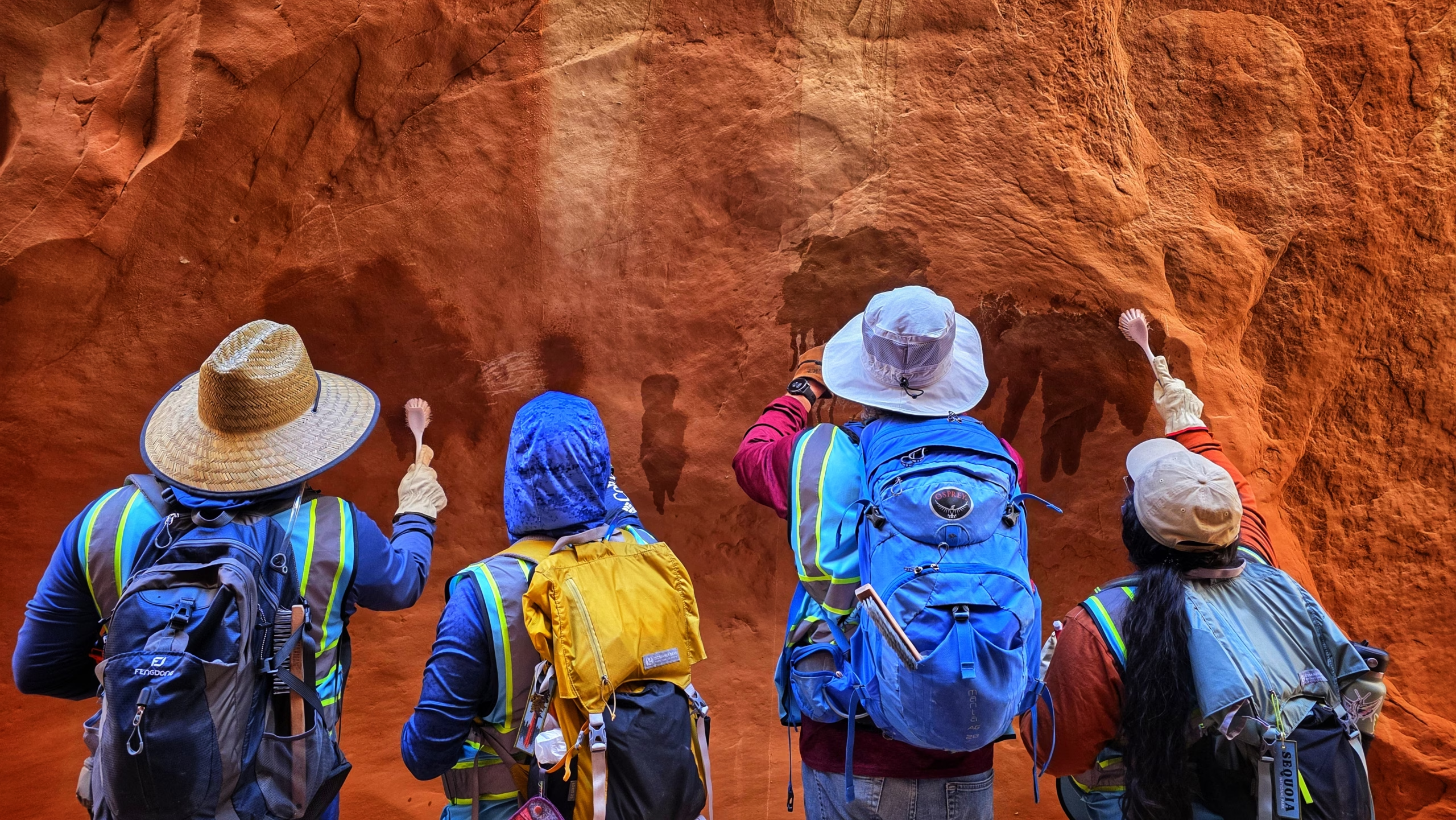
GSEP volunteers remediating graffiti in GSENM. Photo by GSEP staff.
Close your eyes and picture the perfect spring day. You’ve packed your day bag with water and snacks, picked up your favorite hiking companions and set out for one of the most majestic slot canyons on the map! You’ve done your research, marveled at the stunning photos of canyon walls glowing in the golden light and you imagined yourself standing in that very place – held by the smooth sandstone, admiring its unmatched natural beauty.
With the thrill of the hike leading you and your friends on, you step into the impossibly tiny entrance, your senses bursting with excitement, fear and anticipation of what’s around every corner. But as you move deeper into the canyon, that thrill is abruptly replaced by disappointment. What should be the delicate, ancient striations of the rock are now instead covered with deep grooves of tic-tac-toe boards, initials in hearts, crude messages and layers of mindless scratches. Almost every regal inch of the canyon is scarred with the remnants of a hiker before, leaving little room for you to form your own meaningful connection with this extraordinary space.
Every year, Gran d Staircase-Escalante National Monument (GSENM) welcomes hundreds of thousands of visitors, and with that popularity comes one of the most damaging impacts: graffiti. To address this, Grand Staircase Escalante Partners (GSEP) has joined the Bureau of Land Management (BLM) to remediate this impact. GSEP staff are trained to remediate graffiti by BLM specialists in safe and effective practices and educated on its lasting impacts on these fragile formations. Thanks to this partnership, GSEP leads volunteer-supported stewardship projects to help restore the canyon’s integrity and preserve its beauty for future visitors.
d Staircase-Escalante National Monument (GSENM) welcomes hundreds of thousands of visitors, and with that popularity comes one of the most damaging impacts: graffiti. To address this, Grand Staircase Escalante Partners (GSEP) has joined the Bureau of Land Management (BLM) to remediate this impact. GSEP staff are trained to remediate graffiti by BLM specialists in safe and effective practices and educated on its lasting impacts on these fragile formations. Thanks to this partnership, GSEP leads volunteer-supported stewardship projects to help restore the canyon’s integrity and preserve its beauty for future visitors.
There are two big takeaways that GSEP would like to impart on anyone who feels inspired by this work.
- Graffiti remediation is the process of “improving” the damage that has been done by using a minimalist technique. The goal is to alter the appearance of human-made markings so as not to catch the hiker’s attention. Removing graffiti would cause a much larger and more harmful impact to the rock surface. Unfortunately, we can not undo what has been done, but we can reduce the chances of someone else getting the idea to leave a mark as well.
- Graffiti remediation is not a vigilante activity! The GSEP team has been trained and educated on the correct method as well as where it can be done. To the untrained eye, an initial or pecked-in image may appear as current vandalism, however, it may belong to historical or prehistoric records that are to be protected. If you see a marking (scratches, mud, spray paint, etc.) while out on a hike, the best way you can help is to take a photo with a coordinate and report it to the appropriate land management agency.
People have always felt compelled to leave their mark – whether as a form of communication, a record of heritage, a declaration of love or simply as a reminder that they hiked here once. The traces are etched across countless rock walls throughout the monument. Today, guided by Leave No Trace and Visit With Respect principles, we understand these actions cause lasting harm. If every visitor were to pick their favorite flower, pocket a cherished stone, or carve their beloved rock band name into the canyon wall, the monument would quickly lose the very qualities that make it worth visiting.
If you are interested in volunteering on projects like graffiti remediation, please consider visiting the GSEP Volunteer website. You can find a list of the 2025 spring and fall projects along with additional information on how you can get involved as a steward for GSENM.
– Kristen Buck
GSEP Volunteer Programs Manager

